About October 1945 I received a letter from my employer, Thomas Kingston, assuring me that my job would be waiting for me when I got back home to England, adding: "Would you please make it soon!"
Another activity, which was part of the Vocational Training Scheme, was the formation of a concert party group, recruited from some of the British army units on the site. About twenty people in all were involved, most of them Officers and NCO's, a few having had amateur show-business experience and others opting to help backstage as electricians and carpenters, etc. An Officer in my unit, Peter Oliver, was a very good artist, so he was made responsible for designing and painting all the scenery and stage props; he asked me to be his assistant because of my experience in painting tactical signs, etc., on army vehicles. Another of the Officers was asked to write story lines and scripts, and he eventually produced and directed all four of the shows that we put on.
We staged our first show at the Forces' Cinema on our camp at Gulanchi on 22nd October 1945. We used the cinema for rehearsals, and a spare room behind the stage to build and store all the scenery and props for the shows. We were very short of materials for props and costumes so we had to improvise a lot: the programmes were typed on to an "onion-skin" stencil and duplicated on to cheap flimsy brown paper (nevertheless, my copies of the programmes still survive after 50 years, but only just!).

Photocopy of "Without A Clue" programme
from Alf's book
The cast of the show called themselves "The Monsters" and the first show entitled "Without a Clue" was a review, a series of short sketches with some singers and stand-up comedy. We also managed to get a RAF band to help the show along. The show was acclaimed to be a great success, so much so that the Brigadier ordered them to stage a second show at the Forces Club in Poona, to be on 7th November 1945.
This attracted a much wider audience and the club was consequently packed out. This venue was ideal, as the building, previously used as a Civic Centre before the war, had been purposely refitted as a theatre with a large stage and dressing rooms. However, the change of venue caused problems for the backstage staff, who had to transport all the props, scenery and costumes, including the large stage curtains and back-drops, from the camp at Gulanchi to the theatre at Poona before the show and return them afterwards, a journey of about twenty miles each way.
On the success of the first two shows, a third performance was requested by a British field gun unit who were stationed a few miles outside Poona. We put the same show on for them, with local variations, on the 20th November 1945 and they supplied the "Gunners Band" this time. I was Assistant Stage Manager for this show and also for the following one at Christmas, in Poona, which was to be our last.
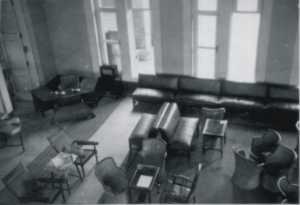
Downstairs at the Forces Club in 1945.
It was inevitable that our final performance should be a special Christmas Pantomime, especially that for most of the British Troops it was to be their last Christmas away from home. The pantomime, "Jack in the Q Stores", was staged at the Forces Club in Poona and a great success it was.
My recollection of dates and places we visited in India is vague because we had little opportunity to keep records of our itinerary and on one occasion, we were ordered to destroy all personal letters and diaries for security reasons. Some of the events recorded here are recalled from old letters and photographs, etc., which I had sent home at the time and are now kept in memorabilia albums (some of which have been scanned and are added here).
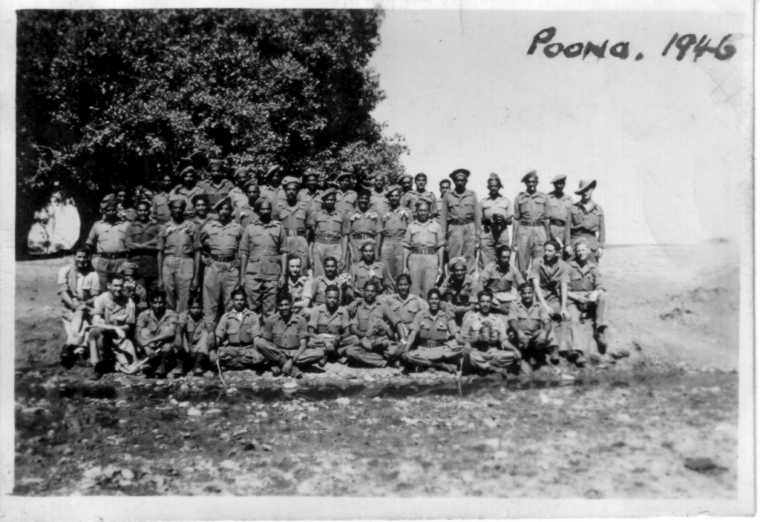
Part of A and B Troops of the 11th Battery of the 9th Rajputana Light Anti-Aircraft Regiment, Royal Indian Artillery, whilst on Scheme near Poona in January 1946.
Alf is front row, far left.
My last long journey across India was by road. Our regiment, the Ninth Rajputs,
was being disbanded and the BOR's integrated into a new unit, the Sixth
Punjabs. Many of us had been with the old regiment for a long time and had
travelled a long way together, so we decided to have an appropriate keepsake
made. A talented fitter in our workshop fashioned for each of us a silver
badge made from a rupee coin. The badge depicted crossed ceremonial ancient
Indian swords, which was the official emblem of the Ninth Rajputana Light
Anti-Aircraft Regiment, Royal Indian Artillery. I still have mine, 50 years
on!
Mike says: it's now in my possession, mounted next
to my dad's medals.
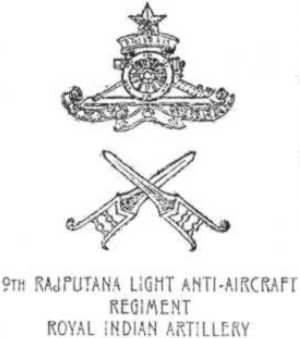
A photocopy of the 9th Rajputana Regiment's emblem,
with the Royal Artillery badge above it, from Alf's book.
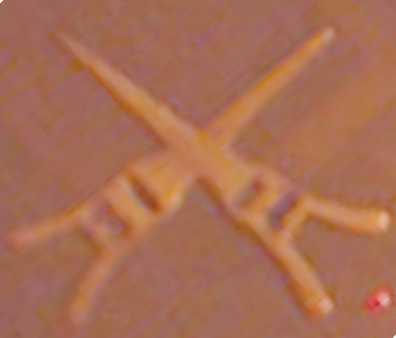
A very poor photo of the 9th Rajputana emblem
- has anyone successfully taken pictures of medals & emblems
inside a 25mm-deep picture frame??
The long journey north started very early in the morning, we moved out in convoy from Gulanchi and it took a whole day for the Battery to leave the camp and if I remember correctly, about two weeks to reach our destination in the Punjab.
We obviously made several stops on the way and had some interesting experiences. We travelled through many towns and villages, some of which we had passed through before or had been stationed there. One such place was Agra. I had been through the town at least twice before by train, but this time we actually camped there, about two miles from the famous Taj Mahal. Although we were hoping to get a chance to visit the building, it wasn't possible because of our travel schedule, and we didn't even see it from a distance...

Sketch for Regimental emblem, by Alf in April
1946.
We also stopped at Delhi and at Lahore, both places I had been to before. We established a temporary headquarters at a smaller town called Wah, which I shall never forget because I remember being asked to paint our new regimental emblem on a concrete plinth outside the main office building. It was a drawing of an elephant, the Sixth Punjab's regimental badge; I never did manage to get a badge for myself, but I did borrow one from an Officer in order to copy it for the emblem which I painted, which was about 4 feet high.
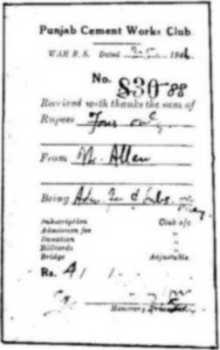
At Wah, the BOR's were invited to take up temporary membership at the
social club of a local factory, the Punjab Cement Works. We paid our
subscription (I still have my receipt) and were allowed to use their
outdoor swimming pool, and that was where I learnt to dive, although
I couldn't swim very well (and still can't). I also learnt to play
snooker there.
We finally reached our destination, Mansar camp near Rawalpindi. I seem to remember there was very little left for the BOR's to do; our duties were probably suspended whilst we were awaiting further orders. Maybe the Indian troops were on leave or elsewhere on an exercise, but most of the British lads, like myself, were awaiting repatriation.
We found the camp very clean and comfortable compared to some we had been in. A group of us would walk across the fields on most days to swim in the local river; a photo taken one day after the swim bears the names of some of the lads and the date - May 1946 - and this is in my photo album (and here, below).
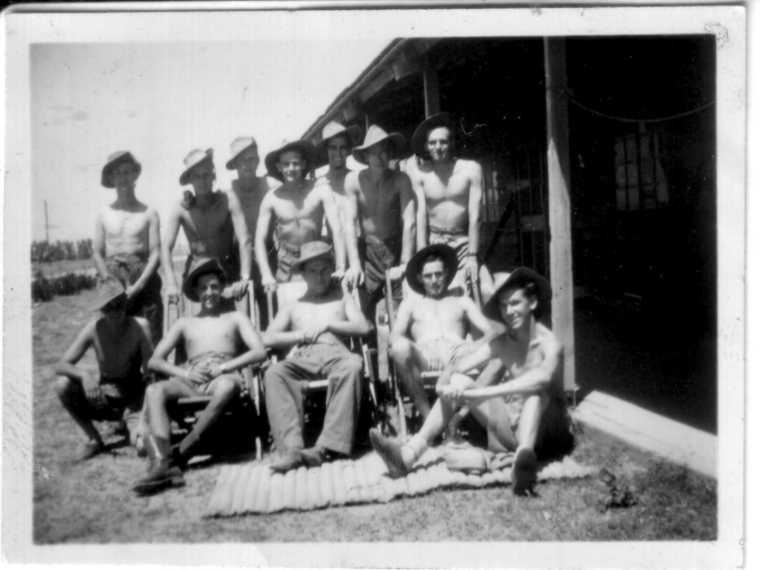
The British Other Ranks of the 6th Punjab Light
Anti-Aircraft Regiment, Royal Indian Artillery, at Mansar Camp, Rawalpindi
in May 1946.
Back row from left: Gilbert, Roulston, Packer, Knowles, Pound, Ewings,
Stevens.
Front row from left: Barnes, Slade, Thorton, Morris, Allen.
The town of Rawalpindi was not far away and we made regular Saturday visits there searching the shops for souvenirs to bring home. One purchase that most of us considered necessary was a large heavy leather suitcase with reinforced straps and buckles, plus wooden battens on the base for added protection, made to order at a local shop. My services were in great demand at the time to paint names on the suitcases, in "Old English". An essential part of our Saturday routine in Rawalpindi was to visit a Chinese restaurant for a meal and for some strange reason most of us would regularly order the same meal every week... eggs, steak, chips and tomatoes!
Continues on page six
